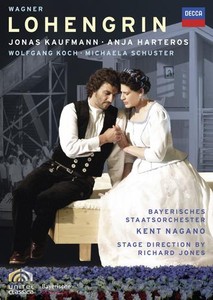
Every new production, no matter how willful, seems to have its champion
in the press, but not Richard Jones's Lohengrin, the debacle of
last year's summer festival at the Bavarian State Opera. The ranking
German critics tarred and feathered it; my impression at a mid-run
performance was that they had been kind. But the cast was
praised to the skies, especially Munich native Jonas Kaufmann in his
role debut as the hero — which also marked his homecoming to a house
that had never thrown him a crumb early on. To my mind, Kaufmann
exceeded the brightest expectations, eclipsing his colleagues
completely.
The video does him justice while at the same
time working wonders for everyone else. Blessed with the leonine face
and mane of Leonardo's Vitruvian Man, Kaufmann conveys an ecstatic
otherworldliness. Swirling through the Act I duel, heedless of
Telramund's fumbling, he embodies an exterminating angel. Throughout,
his bearing, gestures and expressions reflect the isolation of a proud
and righteous soul. Incredibly, he delivers the great narrative of the
Grail sitting in a chair, which would seem to put him at a disadvantage
but somehow doesn't at all. Bleak yet radiant, working the material in
the subtlest shadings of timbre, mood and attack, Kaufmann puts before
us Lohengrin's inner landscape of love, loss and awe.
With the chalk-white face, ink-black curls, wide
crimson smile and level gaze of a Minoan princess, Anja Harteros is
ravishing in close-up as Elsa, and she shapes her music with clarion
passion. Wolfgang Koch, the rumpled Telramund, gives a bruising account
of his character's pain and outrage. In her blonde bob, Michaela
Schuster's Ortrud looks like a heavy-set Edie Falco, and the play of her
features, whether she is singing or silently scheming, gives a viewer
plenty to watch. In the house, she sounded like an overextended
chanteuse, but onscreen her vivid diction and clear projection carry the
day. In Christof Fischesser, the production has a sonorous,
anxiety-ridden King of tremulous integrity. His mobile eyebrows speak
volumes. (The same is true of Kaufmann and Harteros, though they send
very different messages.) Perched on an umpire's chair, with Groucho
specs and an off-kilter wedge of marcelled hair, Evgeny Nikitin sounds
the Herald's bulletins with authority. Kent Nagano, whose conducting
felt square and nondescript in the house, comes off here as efficient
and occasionally eloquent.
Ah yes, the production. Jones and Ultz, his designer,
are both British, but their image bank is Walmart-meets-Oktoberfest.
Lohengrin arrives in a T-shirt and running shoes but dresses for his
wedding like peasant royalty in his Sunday best. Pinned-up braids
abound, as do coats of arms, selectively emblazoned in Gothic lettering.
The newlyweds move into a new two-story home of Elsa's design, the
interior all knotty pine. (It rotates, too.) Through much of Act I, Elsa
(in overalls) is seen laying brick for the place, a task in which
Lohengrin, an army of extras, and momentarily even Ortrud assist. A
flower bed at the footlights spells out the dedicatory couplet Wagner
wrote for Wahnfried, his Bayreuth home, where, as he said, his delusions
came to rest. Betrayed by Elsa, Lohengrin torches the wooden cradle for
the child the couple will never have.
Thus, Jones and Ultz let their cat out of the bag.
What, they ask, is Lohengrin but Wagner's sublimated fantasy of
house and hearth, projected onto Elsa, and through her, onto the hero?
In the theater, the juggernaut production that was mounted to realize
this reductive thesis crushed the performers in the dust. On video,
their searing emotional veracity blasts the show to very occasionally
distracting smithereens.
|